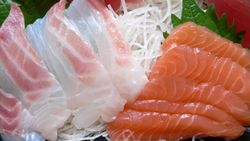
When dining at a Japanese establishment, you may see a selection of raw seafood delicacies on the menu. It can be tough to decide whether to order sushi, sashimi, or nigiri if you don’t know how they differ. To make an informed decision, here are a few key details about each option.
Sushi
A sushi roll is comprised of three layers. The outer layer is a thin sheet of seaweed, or nori. It’s placed on a thin bamboo mat, which serves as a sturdy, flexible base to stack the ingredients. Next, sushi rice is placed over the seaweed. The chef cuts small pieces of raw fish, such as yellowtail or hamachi, and places them atop the rice. The chef rolls the layers together using the mat, then cuts it into small, bite-size pieces. Sushi is typically served with a dollop of wasabi, ginger slices, and soy sauce on the side.
Sashimi
 Unlike sushi, sashimi doesn’t contain seaweed or rice. Instead, the chef carefully cuts the protein into thin slices for simple presentation. Raw seafood, including tuna, salmon, octopus, and sea urchin, is used to create sashimi. In some cases, raw red meat or vegetables may be used. Pickled ginger, wasabi, and radish are served on the side to bring out the salty, buttery, and sweet notes in the protein.
Unlike sushi, sashimi doesn’t contain seaweed or rice. Instead, the chef carefully cuts the protein into thin slices for simple presentation. Raw seafood, including tuna, salmon, octopus, and sea urchin, is used to create sashimi. In some cases, raw red meat or vegetables may be used. Pickled ginger, wasabi, and radish are served on the side to bring out the salty, buttery, and sweet notes in the protein.
Nigiri
When pressed sushi rice is added to sashimi, it becomes nigiri. Whereas sashimi can include meat or vegetables, seafood is used to make nigiri. Shrimp, octopus, tuna, squid, and salmon are common ingredients, and the protein can be cooked, seared, or served raw.
If you want to try mouthwatering, fresh sushi, sashimi, and nigiri, visit McCully Buffet in Honolulu, HI. This restaurant is a favorite among Oahu families who want high-quality, affordable seafood for lunch and dinner. Get more information about their menu online, or call (808) 951-0511 to make a reservation.
About the Business
Have a question? Ask the experts!
Send your question

